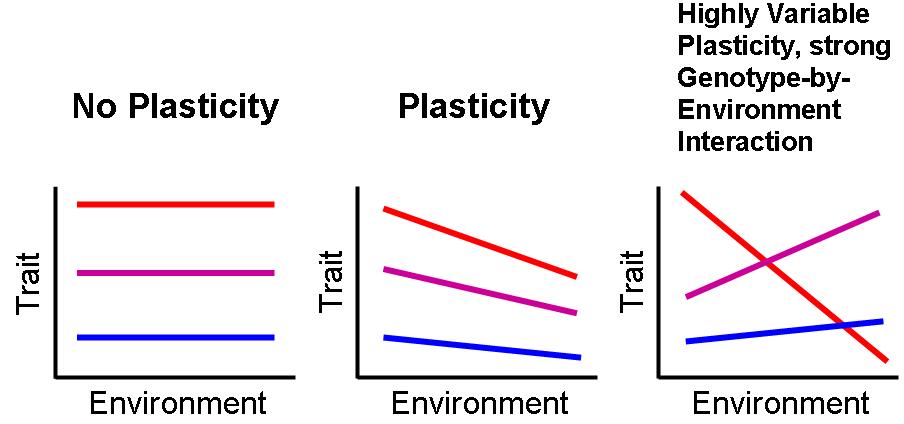
Phenotypic plasticity
Phenotypic plasticity refers to some of the changes in an organism's behavior, morphology and physiology in response to a unique environment.[1][2] Fundamental to the way in which organisms cope with environmental variation, phenotypic plasticity encompasses all types of environmentally induced changes (e.g. morphological, physiological, behavioural, phenological) that may or may not be permanent throughout an individual's lifespan.[3]
The term was originally used to describe developmental effects on morphological characters, but is now more broadly used to describe all phenotypic responses to environmental change, such as acclimation (acclimatization), as well as learning.[3] The special case when differences in environment induce discrete phenotypes is termed polyphenism.
Generally, phenotypic plasticity is more important for immobile organisms (e.g. plants) than mobile organisms (e.g. most animals), as mobile organisms can often move away from unfavourable environments.[4] Nevertheless, mobile organisms also have at least some degree of plasticity in at least some aspects of the phenotype.[2]
One mobile organism with substantial phenotypic plasticity is Acyrthosiphon pisum of the aphid family, which exhibits the ability to interchange between asexual and sexual reproduction, as well as growing wings between generations when plants become too populated.[5]
Water fleas (Daphnia magna) have shown both phenotypic plasticity and the ability to genetically evolve to deal with the heat stress of warmer, urban pond waters.[2]
Evolution[edit]
Plasticity is usually thought to be an evolutionary adaptation to environmental variations that is reasonably predictable and occurs within the lifespan of an individual organism, as it allows individuals to 'fit' their phenotype to different environments.[49][50] If the optimal phenotype in a given environment changes with environmental conditions, then the ability of individuals to express different traits should be advantageous and thus selected for. Hence, phenotypic plasticity can evolve if Darwinian fitness is increased by changing phenotype.[51][52] A similar logic should apply in artificial evolution attempting to introduce phenotypic plasticity to artificial agents.[53] However, the fitness benefits of plasticity can be limited by the energetic costs of plastic responses (e.g. synthesizing new proteins, adjusting expression ratio of isozyme variants, maintaining sensory machinery to detect changes) as well as the predictability and reliability of environmental cues[54] (see Beneficial acclimation hypothesis).
Freshwater snails (Physa virgata), provide an example of when phenotypic plasticity can be either adaptive or maladaptive. In the presence of a predator, bluegill sunfish, these snails make their shell shape more rotund and reduce growth. This makes them more crush-resistant and better protected from predation. However, these snails cannot tell the difference in chemical cues between the predatory and non-predatory sunfish. Thus, the snails respond inappropriately to non-predatory sunfish by producing an altered shell shape and reducing growth. These changes, in the absence of a predator, make the snails susceptible to other predators and limit fecundity. Therefore, these freshwater snails produce either an adaptive or maladaptive response to the environmental cue depending on whether predatory sunfish are present or not.[55][56]
Given the profound ecological importance of temperature and its predictable variability over large spatial and temporal scales, adaptation to thermal variation has been hypothesized to be a key mechanism dictating the capacity of organisms for phenotypic plasticity.[57] The magnitude of thermal variation is thought to be directly proportional to plastic capacity, such that species that have evolved in the warm, constant climate of the tropics have a lower capacity for plasticity compared to those living in variable temperate habitats. Termed the "climatic variability hypothesis", this idea has been supported by several studies of plastic capacity across latitude in both plants and animals.[58][59] However, recent studies of Drosophila species have failed to detect a clear pattern of plasticity over latitudinal gradients, suggesting this hypothesis may not hold true across all taxa or for all traits.[60] Some researchers propose that direct measures of environmental variability, using factors such as precipitation, are better predictors of phenotypic plasticity than latitude alone.[61]
Selection experiments and experimental evolution approaches have shown that plasticity is a trait that can evolve when under direct selection and also as a correlated response to selection on the average values of particular traits.[62]
Plasticity and climate change[edit]
Unprecedented rates of climate change are predicted to occur over the next 100 years as a result of human activity.[67] Phenotypic plasticity is a key mechanism with which organisms can cope with a changing climate, as it allows individuals to respond to change within their lifetime.[68] This is thought to be particularly important for species with long generation times, as evolutionary responses via natural selection may not produce change fast enough to mitigate the effects of a warmer climate.
The North American red squirrel (Tamiasciurus hudsonicus) has experienced an increase in average temperature over this last decade of almost 2 °C. This increase in temperature has caused an increase in abundance of white spruce cones, the main food source for winter and spring reproduction. In response, the mean lifetime parturition date of this species has advanced by 18 days. Food abundance showed a significant effect on the breeding date with individual females, indicating a high amount of phenotypic plasticity in this trait.[69]